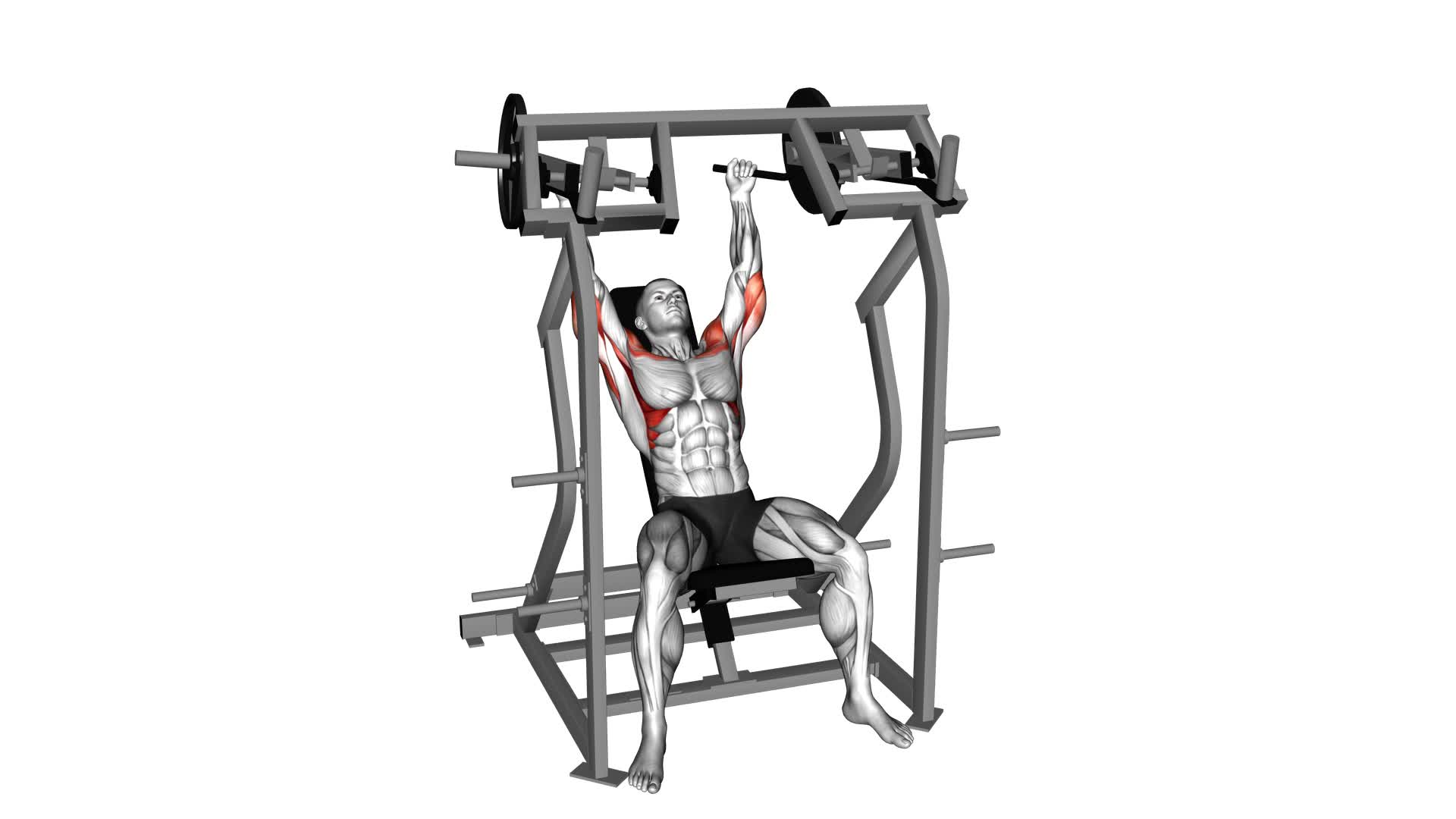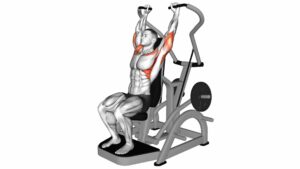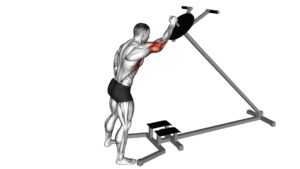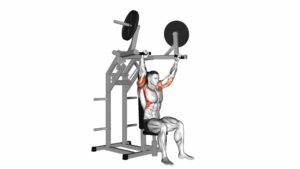Lever Shoulder Press (Plate Loaded) (Version 2) – Video Exercise Guide & Tips

Get ready to level up your shoulder workout with the Lever Shoulder Press (Plate Loaded) (Version 2).
Watch This Exercise Video
In this video exercise guide, we'll show you how to perform this powerful exercise with proper form and technique.
You'll also learn about common mistakes to avoid, variations and progressions to challenge yourself, and important tips for a safe and effective workout.
Get ready to strengthen and sculpt your shoulders like never before.
Let's press on!
Key Takeaways
- Engages multiple muscle groups, including deltoids, triceps, and upper back
- Improves upper body strength and stability
- Provides a greater range of motion compared to other shoulder exercises
- Offers a safer alternative to traditional shoulder presses with free weights
Benefits of Lever Shoulder Press (Version 2)
To maximize your shoulder strength and stability, the Lever Shoulder Press (Version 2) offers numerous benefits. This exercise specifically targets the muscles in your shoulders, providing effective muscle activation during each repetition. The lever shoulder press activates the anterior deltoids, medial deltoids, and triceps, making it an excellent exercise for overall shoulder development.
When comparing the lever shoulder press to other shoulder exercises, it stands out for several reasons. Unlike traditional dumbbell or barbell presses, the lever shoulder press provides a more controlled and stable movement. This reduces the risk of injury and allows you to focus solely on working your shoulder muscles. Additionally, the lever shoulder press offers a greater range of motion compared to machines that restrict movement.
Transitioning into the subsequent section about proper form and technique for the lever shoulder press, it's important to understand the benefits you can gain from this exercise. By following the correct form and technique, you can maximize the effectiveness of the exercise and prevent any potential injuries.
Let's now delve into the proper form and technique for the lever shoulder press to ensure you get the most out of this exercise.
Proper Form and Technique for Lever Shoulder Press
To ensure you get the most out of the lever shoulder press and avoid potential injuries, it's crucial to understand and implement proper form and technique. Maintaining shoulder stability during the exercise is essential for maximizing its benefits and preventing unnecessary strain on the joints.
Firstly, it's important to position yourself correctly on the machine. Sit with your back firmly against the backrest and adjust the seat height so that your elbows are at a 90-degree angle when gripping the handles. This will ensure optimal range of motion for the lever press.
During the exercise, focus on keeping your shoulders stable and avoid excessive movement or rotation. Engage your core muscles to maintain proper alignment and stability throughout the movement. It's also important to avoid locking out your elbows at the top of the press to prevent unnecessary stress on the joint.
Additionally, maintain a controlled and slow tempo throughout the exercise, both on the eccentric (lowering) and concentric (pressing) phases. This will help you maintain proper form and prevent any jerking or swinging motions that can lead to injury.
By implementing these proper form and technique tips, you'll be able to perform the lever shoulder press effectively and safely.
Now, let's move on to the next section where we'll discuss common mistakes to avoid during the lever shoulder press.
Common Mistakes to Avoid During Lever Shoulder Press
Avoid these common mistakes to maximize the effectiveness and safety of your lever shoulder press.
Proper form and technique are crucial for injury prevention and getting the most out of your workout.
One common mistake is using excessive weight. It's important to start with a weight that allows you to maintain proper form throughout the exercise. Using too much weight can lead to poor technique and increase the risk of injury.
Another mistake to avoid is arching your back. Keep your back straight and engage your core muscles to maintain stability. Arching your back puts unnecessary strain on your spine and can lead to back pain or injury.
Additionally, avoid locking your elbows at the top of the movement. Locking your elbows can increase the stress on your joints and potentially cause discomfort or injury. Instead, maintain a slight bend in your elbows throughout the exercise.
Lastly, don't rush through the movement. Perform the exercise in a controlled manner, focusing on proper form and technique.
Variations and Progressions for Lever Shoulder Press
Try incorporating different variations and progressions to challenge yourself during the lever shoulder press exercise. By adding variations to your workout routine, you can target different muscles and increase the difficulty of the exercise.
One variation you can try is the single-arm lever shoulder press. Instead of using both arms simultaneously, perform the exercise with one arm at a time. This will engage your core muscles more and improve stability.
Another variation is the seated lever shoulder press. Instead of standing, sit on a bench or chair while performing the exercise. This variation puts less stress on your lower back and allows you to focus more on your shoulder muscles.
To progress in your lever shoulder press, you can gradually increase the weight you're lifting. Start with a weight that challenges you but allows you to maintain proper form. As you get stronger, gradually add more weight to continue challenging yourself. You can also increase the number of repetitions or sets you perform. This will help improve muscular endurance and overall strength.
Incorporating variations and progressions into your lever shoulder press routine can help prevent plateaus and keep your workouts interesting and challenging. Now, let's move on to the next section for tips on how to perform the lever shoulder press safely and effectively.
Tips for a Safe and Effective Lever Shoulder Press Workout
To perform a safe and effective lever shoulder press workout, focus on maintaining proper form and engaging your shoulder muscles throughout the exercise. Here are some tips to help you get the most out of your workout while keeping it safe.
First and foremost, it's important to use safe techniques when performing the lever shoulder press. Start by sitting with your back firmly against the backrest and your feet planted firmly on the ground. Keep your core engaged and your spine neutral throughout the exercise. When pushing the lever up, avoid locking your elbows and instead maintain a slight bend to prevent unnecessary strain on your joints.
Additionally, it's crucial to choose the right amount of weight for your level of fitness. Start with a weight that allows you to perform the exercise with proper form and without excessive strain. As you become stronger and more comfortable with the exercise, gradually increase the weight to continue challenging your muscles.
Remember, proper form and technique are key to a safe and effective workout. If you experience any pain or discomfort during the exercise, stop immediately and consult with a fitness professional.
Frequently Asked Questions
How Many Sets and Reps Should I Do for Lever Shoulder Press (Version 2) to See Results?
To see results from the lever shoulder press (version 2), it's important to focus on both sets and reps. Start with a weight that challenges you, but still allows for proper form and technique.
Aim for 3-4 sets of 8-12 reps, with a rest period of 1-2 minutes between sets. This will help build strength and muscle endurance.
Remember to prioritize safety and avoid shoulder injuries by maintaining proper form throughout the exercise.
Can I Perform Lever Shoulder Press (Version 2) With Dumbbells Instead of a Plate-Loaded Machine?
Yes, you can perform the lever shoulder press (version 2) with dumbbells instead of a plate-loaded machine. This dumbbell substitution offers several benefits.
It allows for a greater range of motion, engages stabilizer muscles, and improves overall shoulder strength and stability. Additionally, using dumbbells can provide a more balanced and symmetrical workout.
Just make sure to choose an appropriate weight and maintain proper form throughout the exercise to maximize the benefits.
Is It Necessary to Warm up Before Doing Lever Shoulder Press (Version 2)?
Before performing any exercise, it's important to warm up your muscles to prevent injury and optimize performance.
Dynamic stretching can be an effective warm up for the lever shoulder press (version 2). It helps increase blood flow to the muscles and improves range of motion.
For beginners, starting with a lighter weight is advisable to ensure proper form and technique.
Gradually increase the weight as you become more comfortable and confident with the exercise.
Are There Any Specific Breathing Techniques I Should Follow While Performing Lever Shoulder Press (Version 2)?
When performing the lever shoulder press (version 2), it's important to focus on your breathing techniques. Take a deep breath in before you start the exercise and exhale as you push the weight up. This will help you maintain stability and engage your core muscles.
One common mistake is holding your breath during the movement, which can lead to increased tension and decreased performance. Remember to breathe rhythmically throughout the exercise for optimal results.
Can I Incorporate Lever Shoulder Press (Version 2) Into My Full-Body Workout Routine?
Yes, you can definitely incorporate lever shoulder press (version 2) into your full-body workout routine. It offers numerous benefits for shoulder strength and stability.
By adding this exercise, you can target your deltoids, triceps, and upper back muscles. It also helps in improving posture and overall upper body strength.
Make sure to start with a weight that challenges you but allows you to maintain proper form.
Incorporating this exercise will enhance your full-body workout routine and contribute to your overall fitness goals.
Conclusion
In conclusion, the Lever Shoulder Press (Version 2) is a beneficial exercise for targeting and strengthening the shoulder muscles. By maintaining proper form and technique, you can maximize the effectiveness of this exercise and avoid common mistakes.
Additionally, incorporating variations and progressions can challenge your muscles and promote continuous growth. Remember to prioritize safety and follow these tips for a safe and effective Lever Shoulder Press workout.

Author
Years ago, the spark of my life’s passion ignited in my mind the moment I stepped into the local gym for the first time. The inaugural bead of perspiration, the initial endeavor, the very first surge of endorphins, and a sense of pride that washed over me post-workout marked the beginning of my deep-seated interest in strength sports, fitness, and sports nutrition. This very curiosity blossomed rapidly into a profound fascination, propelling me to earn a Master’s degree in Physical Education from the Academy of Physical Education in Krakow, followed by a Sports Manager diploma from the Jagiellonian University. My journey of growth led me to gain more specialized qualifications, such as being a certified personal trainer with a focus on sports dietetics, a lifeguard, and an instructor for wellness and corrective gymnastics. Theoretical knowledge paired seamlessly with practical experience, reinforcing my belief that the transformation of individuals under my guidance was also a reflection of my personal growth. This belief holds true even today. Each day, I strive to push the boundaries and explore new realms. These realms gently elevate me to greater heights. The unique combination of passion for my field and the continuous quest for growth fuels my drive to break new ground.







